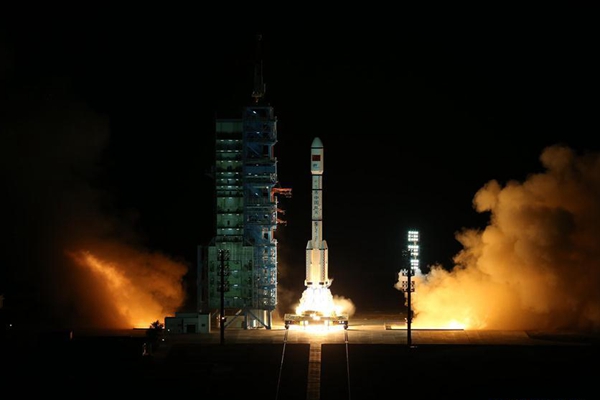China declares success of launching Tiangong-2
 0 Comment(s)
0 Comment(s) Print
Print E-mail Xinhua, September 15, 2016
E-mail Xinhua, September 15, 2016
|
|
|
China's space lab Tiangong-2 roars into the air on the back of a Long March-2F rocket from the Jiuquan Satellite Launch Center in northwest China, Sept. 15, 2016. [Photo/Xinhua] |
China on Thursday launched space lab Tiangong-2 into space, paving the way for a permanent space station the country plans to build around 2022.
In a cloud of brown smoke, Tiangong-2 roared into the air underneath a mid-autumn full moon from the Jiuquan Satellite Launch Center on the back of a Long March-2F rocket, trailing a vast volume of flame.
Once in space, the 8.6-tonne Tiangong-2 will maneuver itself into an orbit about 380 kilometers above Earth for initial on-orbit tests, Wu Ping, deputy director of China's manned space engineering office, said on Wednesday.
The space lab will then transfer to a slightly higher orbit at about 393 kilometers above Earth, a height at which the future Chinese space station will be operating, before the Shenzhou-11 manned spaceship ferries two male astronauts into space to dock with the lab. The two astronauts will work in the lab for 30 days, before reentering Earth's atmosphere.
In April 2017, China's first cargo ship Tianzhou-1, which literally means "heavenly vessel," will also be sent into orbit to dock with the space lab and provide it with fuel and other supplies.
Wu said experts will verify and evaluate key technologies involved in on-orbit propellant resupply and equipment repairing, as well as those related to astronauts' long-term stay in space in the mission process.
They will also use the lab, which is designed to operate for at least two years, to conduct space science experiments on a relatively large scale compared with China's previous efforts.
China's manned space program has now entered a "new phase of application and development," Wu said.







Go to Forum >>0 Comment(s)